
The Last Romantics is a book I return to over and over again while doing research for this blog. It is, without a doubt, the best overall book on the Pre-Raphaelites and Symbolists that exists in print, especially for someone looking for information on specific artworks.
I still remember finding a copy at the University library and realizing I'd hit the jackpot! It's stuffed with lavish photographs and excellent articles on the artists and their work (I've noticed that a lot of museums seem to be lifting catalogue descriptions from this book--either that, or the book is borrowing its articles from museum catalogues. Either way, your getting a very reliable resource, though you can certainly tell that the writers are clearly art historians, not historians--I would have been hauled before an ethics committee in no time if I'd been that cavalier with my sources).
Back to the book itself! The Last Romantics covers the romantic tradition in British Art from Edward Burne-Jones to Stanley Spencer. Hundreds of paintings are included in the volume, though the authors have chosen to steer clear of the decorative arts. The book is filled with unabashed praise for the romantic movement, which is something of a coup, since curators are (generally speaking) rather fond of mocking romantic painters, the Pre-Raphaelites in particular.
If you ever come across a copy of this book, buy it! And if you find two, send me one! I still have mine from the library, but I think I'm going to have to break down and order a copy from Amazon (a couple of the copies available from sellers in the United States are very affordable). The University is going to make me return it sooner or later!
Image courtesy Amazon.com
Monday, June 30, 2008
The Last Romantics
Posted by
Margaret
at
5:44 AM
4
comments
![]()
![]()
Labels: books
Thursday, June 26, 2008
Greek Vase from British Museum depicting Ulysses and the Sirens
In Greek mythology, the Sirens were depicted as creatures with the heads of women and the bodies of birds. The Sirens lived on an island and lured unwary sailors to their rocky shores with their songs (Virgil V, 846; Ovid XIV, 88). They feature prominently in the tale of Ulysses/Odysseus and also of the Argonauts (you will recall that it is Orpheus who saves the Argonauts from the sirens by playing his own tune, whereas Ulysses takes a more direct approach--plugging his sailors' ears and having himself tied to the mast).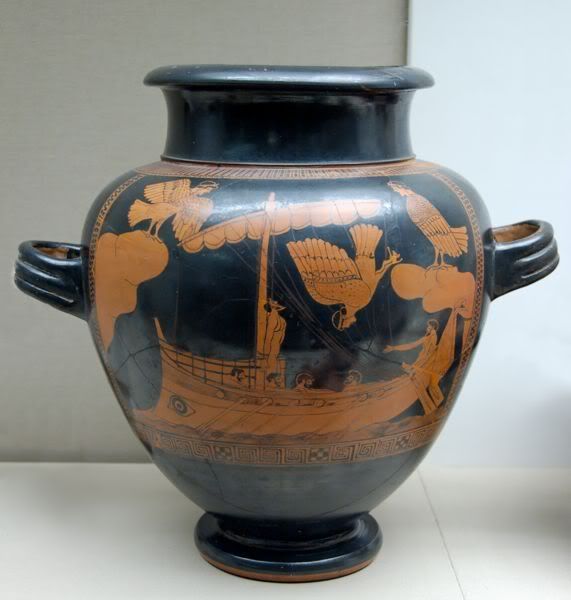
This red Attic vase from the British Museum (ca. 480-470 BC) is thought to have inspired John William Waterhouse's painting of Ulysses and the Sirens. There are a few differences, for example Waterhouse shows 6 Sirens in his painting, whereas this vase appears to only depict 3 (I have not seen the vase myself, so I'm not sure what's shown on the opposite side). But after examining the two pieces a little more closely, I think it's undeniable that Waterhouse used the vase as inspiration for his artwork.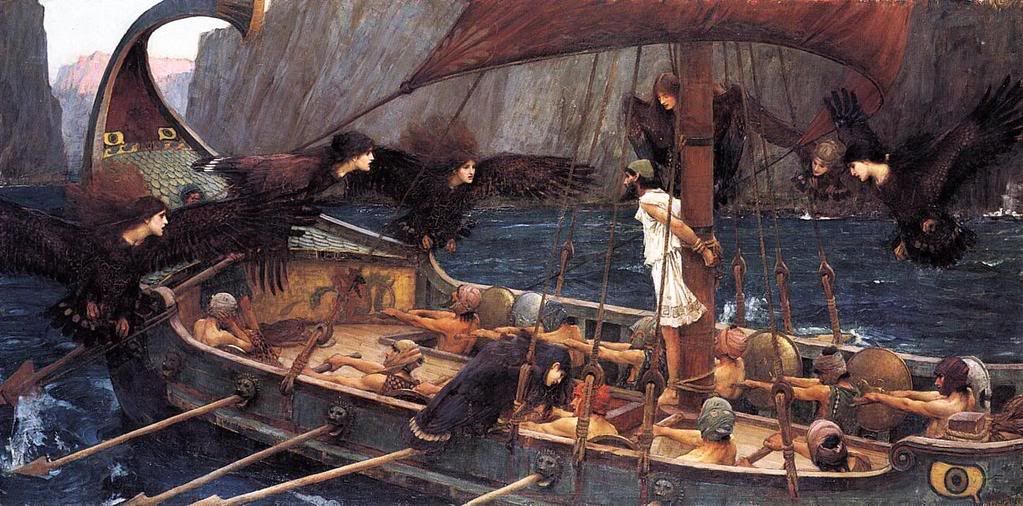
You can tell from this close up that although Waterhouse has chosen to update the Sirens' hairstyles, he has copied their body shape directly from the vase. Likewise the form of the boat and the oars certainly evokes the style depicted on this piece of pottery. You'll also notice that they eyes that decorate the boat are common to both renditions.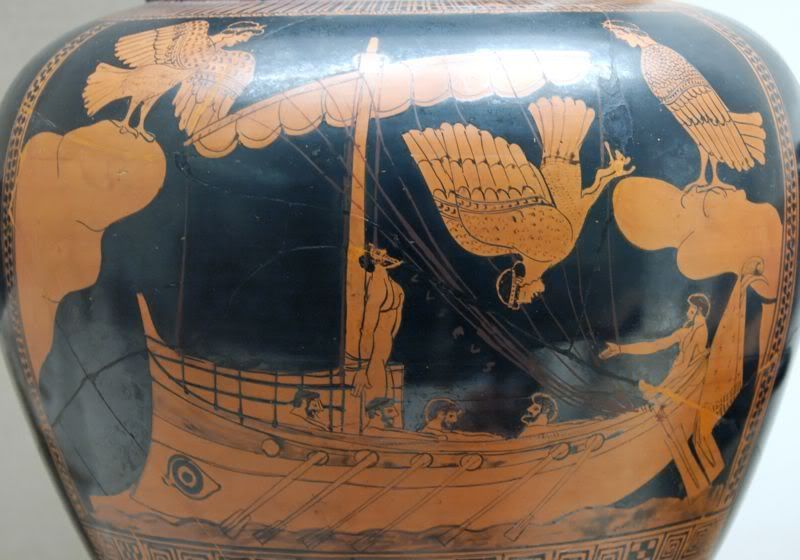
images courtesy wikimedia commons.
Posted by
Margaret
at
5:15 AM
6
comments
![]()
![]()
Labels: mythology, waterhouse
Tuesday, June 24, 2008
John William Waterhouse takes on Ulysses and the Sirens
Yesterday I noted that The Times was quite critical of Herbert James Draper's 1909interpretation of Homer's Sirens. Perhaps that is because 18 years before his painting was exhibited, John William Waterhouse had shown his own pictorial representation of Ulysses and the Sirens.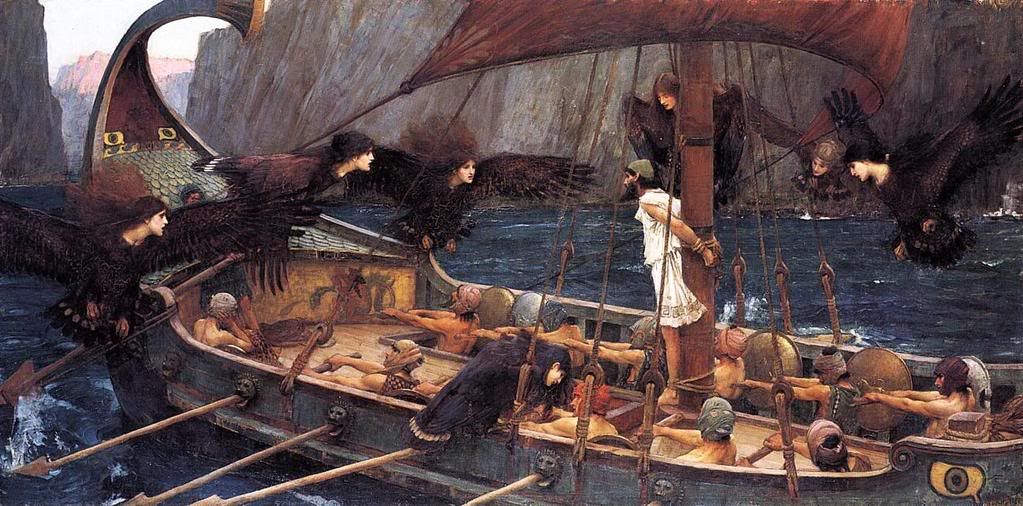
Unlike Draper, who leaned rather heavily on artistic license, Waterhouse was extremely careful to include specific details from the story that only would have been apparent to someone with more intimate knowledge of history. For example, as Australia's National Gallery has pointed out, the faces of Homer and his men, their clothing and helmets, and the boat's design have all been inspired by genuine artifacts.
Furthermore, you'll recall that critics were outraged that Draper portrayed the Sirens as mermaids. But when Waterhouse's rendition of the scene was exhibited 18 years before, critics noted that Waterhouse was one of the first artists to portray the Sirens as bird-like figures, something he might have noticed on a trip to the British Museum, which houses an ancient Greek red figure vase depicting the Sirens as birds.
I appreciate Waterhouse's version because it transports the viewer into the story of Ulysses and has a very clear narrative quality. Draper's portrayal seems to be telling a different tale altogether, but it's so lovely that I can hardly fault it. Both are lovely.
Posted by
Margaret
at
5:13 AM
4
comments
![]()
![]()
Labels: mythology, waterhouse
Monday, June 23, 2008
Herbert James Draper Ulysses and the Sirens
Herbert James Draper (1864-1920) was born in London and studied at St. John's Wood Art School prior to entering the Royal Academy Schools in 1884. Draper showed talent early on and received a gold medal and a scholarship that helped him to travel to Rome and to study at Academie Julian in Paris.
Draper showed his works at the Royal Academy from 1897 until his death, although he was never a member of the Academy (or even an associate). Most of his paintings dealt with subjects from English poetry, particularly anything having to do with the sea.
This painting, Ulysses and the Sirens, was exhibited at the Academy in 1909. But while it was given a central place, the work was strongly criticised. The Times took a particularly dim view of the work, arguing that "Homer's sirens had nothing to do with the conventional mermaid, and did not cling to the ship; they were beings of an undescribed form who sat in a meadow and sang. Really painters ought not thus to amend the text of their authorities." It seems odd today that an artist would receive such harsh criticism for wandering from his source material, but this was a serious consideration in the Victorian art world. I'm afraid they had little patience with artistic liberties!
I love the exceptional beauty of the figures in Draper's paintings, which reminds me a great deal of some of Waterhouse's other works. Draper does an excellent job of capturing the irresistible sensuality of the sirens, whereas Waterhouse's painting of Ulysses and the Sirens seems to focus more on their magical qualities.
According to Homer's tale, three sirens were rumoured to live on an island close to Cape Pelorus in Sicily. The ladies were said to be able to lure sailors to their deaths with their beautiful voices. Having been forewarned by Circe about the sirens, Ulysses filled his crewmen's ears with wax in order to keep them from jumping overboard. However, if the sirens had been as lovely as the sea maidens in Draper's version, I'm not entirely sure that merely being deaf to their songs would have helped very much!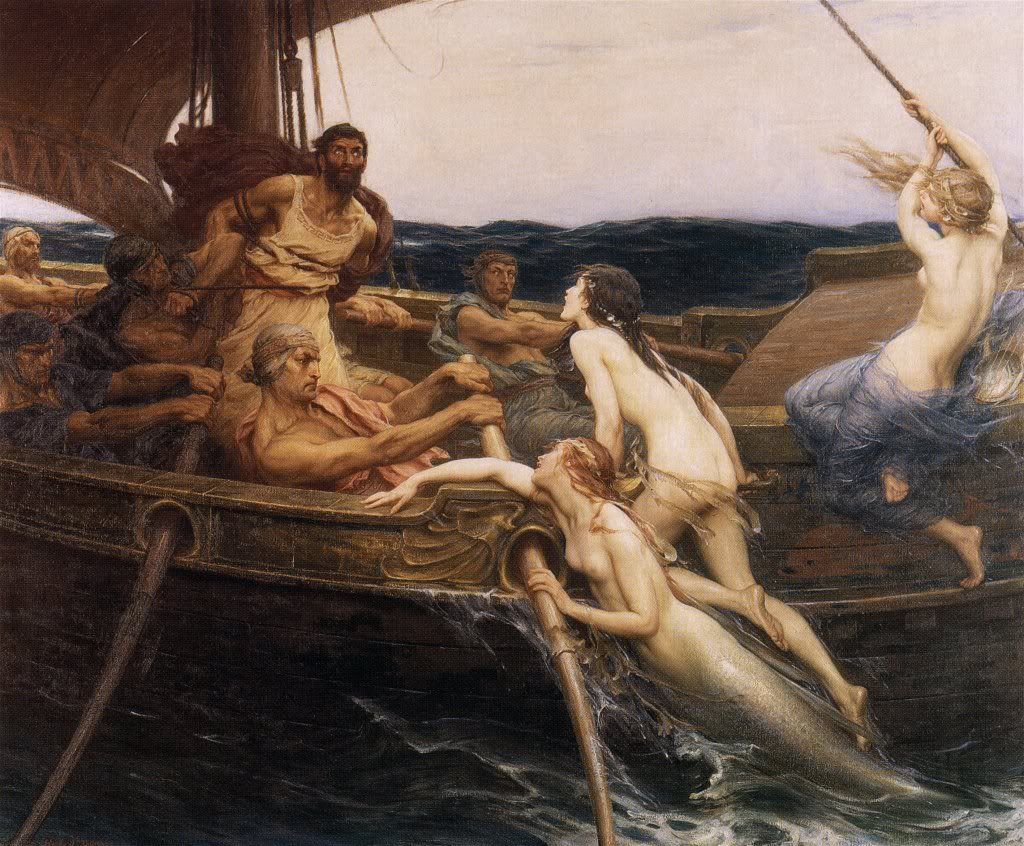
This post owes much of its biographical info to an excellent article on Draper that is included in The Last Romantics (page 127).
image courtesy of wikimedia commons.
Posted by
Margaret
at
5:33 AM
3
comments
![]()
![]()
Labels: mythology
Friday, June 20, 2008
Playa Blanca, near Rodadero in Santa Marta
The boat trip from Rodadero to La Playa Blanca (the white beach)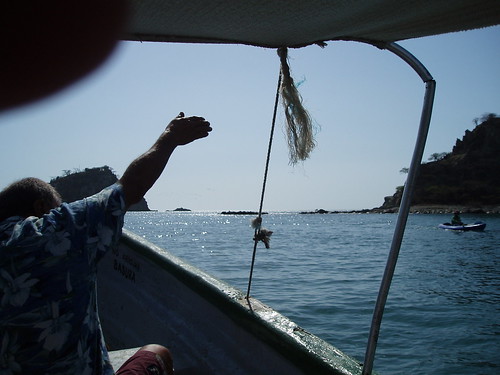
Santa Marta rests on Colombia's Caribbean coast and is one of the most popular tourist destinations in Colombia, along with Cartagena.
We are actually staying in the small resort town of Rodadero, which is just a few minutes away from Santa Marta. Rodadero is well known for its beach, which is described in tourist literature as "white," which is quite a stretch of the imagination. The sand is grey and rather dirty, but it's conveniently located next to the resorts that line the beach. It's great for sunbathing and taking in the local colour (and eating a wide variety of amazing tropical treats--there are people that march up and down the beach all day selling fruit, drinks, beer (yes, you can swim and drink here in Colombia--though I would not recommend it), massages, hair braiding and the like.
If swimming is what you are into, take the time to go hire a boat to take you to Playa Blanca "white beach" for about 5 dollars (less if you are with a group). No need to reserve a boat ahead of time. If you walk anywhere on the beach in Rodadero, there are dozens of boatmen that will offer to take you to Playa Blanca, which is located on the right hand side of the bay. Or, if you prefer to walk in the sweltering heat, there is a path that will get you to the beach in a half an hour or so (in my opinion, the 5 bucks is well worth it, unless you have a bike).
One of the houses we spied on the way to Playa Blanca
Playa Blanca is much more low key than El Rodadero, although there are still plenty of services available to tourists. You can go snorkeling for hours for 8 dollars (which includes a lesson and transport to the reef). If you have goggles, take them to the beach, even if you aren't snorkeling! You'll want to take a look at some of the beautiful fish under the water.
Once you're tired swimming, there are vendors everywhere along the little beach that will be happy to sell you water, juice or a beer. In addition, there are four restaurants on the tiny beach. 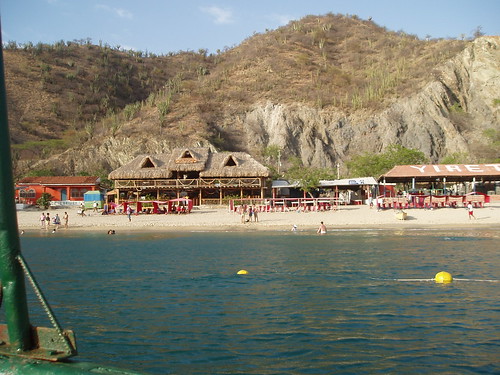
Posted by
Margaret
at
5:13 AM
5
comments
![]()
![]()
Thursday, June 19, 2008
Colombia: First Impressions
I arrived in Baranquilla, Colombia last Thursday after a long flight. One of the first things that struck me was how nice the airport was! It was something I wasn't expecting. (My brother in law later told me that 80% of Colombians have never been on a plane, which helps explain why the airports have such a luxurious atmosphere, but more on that later).
After going through customs (a breeze) and border security (a bit of a pain--they rifle through all of your belongings, but I suppose it's necessary, though I'm not sure exactly what they think I might bring INTO Colombia) we emerged from the air conditioned airport and into the sweltering heat, which was a little bit overwhelming at first (it must have been close to a hundred degrees, and very humid). We met Javier's brother Fabio and his father (also Fabio) at the airport--it was so nice to finally meet them!).
From the airport we could see a bit more of the city of Baranquilla, which like the rest of Colombia, is a city full of contrasts, though the difference between rich and poor is the most striking. Immeadiately outside the airport are rows and rows of extremely meagre dwellings--roofs with the suggestion of walls. The owners sit or stand outside, attempting to sell fruit or souveniers to tourists. One thing I must say is that street vendors here are MUCH less pushy than I've seen in other parts of the world (Paris, for example). All you need to do is say "thanks" and move on. They won't bother you (as a side note though, if you're in a car, it's best to ignore them!).
The ride from Baranquilla to Santa Marta was extremely beautiful at times, and rather depressing at other times. There are a lot of invasiones--what we might call shanty towns--on the hour long drive to Santa Marta. The poverty is extreme, although I was relived to learn that there are schools for all of the kids you can see in these poor neighbourhoods. On the brighter side, we also saw lots of beautiful tropical trees and flowers from the road. The topography was so interesting, and it's amazing how much the land can change during a one hour drive (Baranquilla was humid and more lush, whereas as we approached Santa Marta the landscape became more dry and rocky). 
We are actually staying in Rodadero, which is a large suburb of Santa Marta that has grown as a result of tourism. There are a large number of luxury resorts located near the beach, in addition to luxury apartments and numerous tourist-oriented shops. As you can see, our apartment is just a stone's throw from the beach (this photo was taken fromt the window). 
Posted by
Margaret
at
4:41 AM
3
comments
![]()
![]()
Wednesday, June 18, 2008
Sacred and Profane Stained Glass from the Cluny
One of the things I admire most about the Middle Ages was that it was a period in which people embraced the connection between the material and the spiritual. But there was a downside to this as well. It was an extremely brutal world! This is particularly evident in the religious art of the period, which can be rather shocking to those of us reared with more Victorian conceptions of what constitutes appropriate decoration for places of worship.
They say a picture is worth a thousand words, and these examples of 13th century stained glass from the Cluny museum have got to be worth at least that. Unfortunately, a couple are a bit blurry, but I'm sure the sentiment won't be lost.
Here we have a piece of stained glass that illustrates part of the story of Samson. Rather than showing any uplifting picture of Samson tearing down the city gate, or even a picture of Delilah cutting his hair as he sleeps, the artist has chosen to show the act of his eyes being poked out. Rather dramatic! 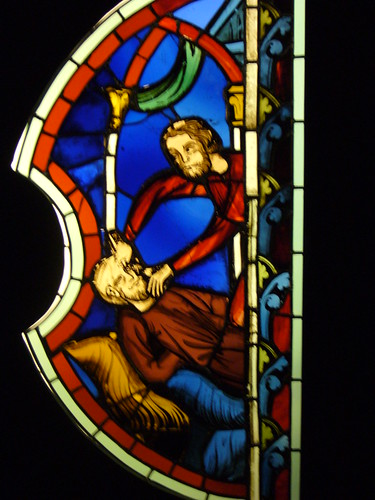
Here we have a rather blurry (sorry) image of John the Baptist being dispatched. Also Interesting because the artists have chosen to show John the Baptist in (then)contemporary clothing. 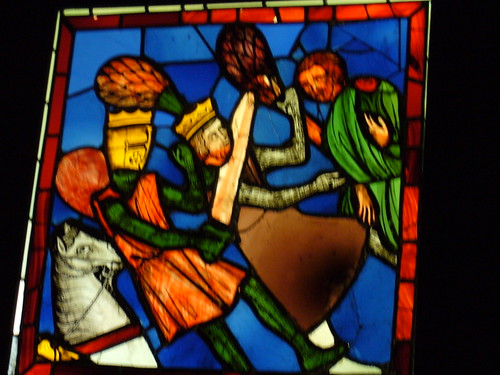
Here we have a rather graphic vision of souls being awakened for the last judgement. 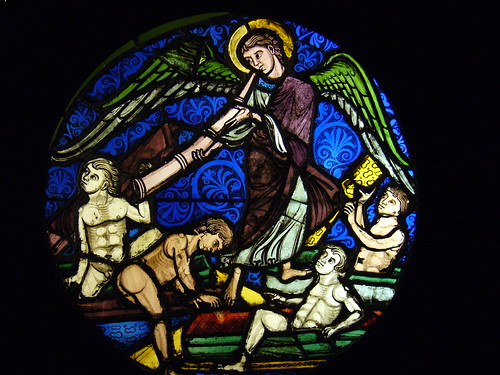
Posted by
Margaret
at
5:02 AM
3
comments
![]()
![]()
Tuesday, June 17, 2008
Tapestry Resources
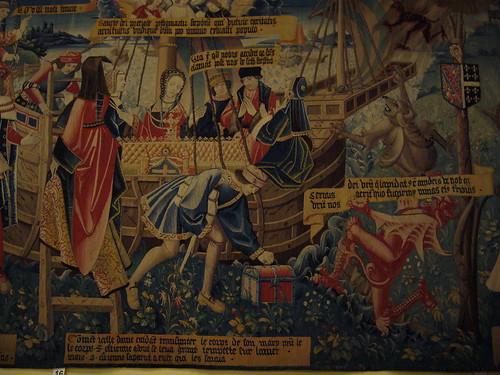
If you visit France and take a look around any of the museum gift shops, you will see dozens of beautiful tapestries for sale. Most are made in France and all of them are frighteningly expensive.
Luckilly, before I went to Paris I discovered a couple of great tapestry retailers. If you are looking for quality tapestry designs from your home, The Tapestry House is probably the best resource available. They are recommended by the New York Times. If you are looking for reproductions of larger tapestries, such as the Unicorn tapestries, this is the place to go.
Although I love smaller design firms like Charles Rupert, this is definitely the most affordable place to find tapestries and they get their products from the same place that smaller design firms do (from the factories that weave them). Most of their products are made in France and they are identical to the tapestries sold in pricey giftshops. Those tapestries that are not woven in Europe are made in the United States.
If you are on the lookout for smaller tapestries, The Tapestry Standard is another great website. They carry a wide variety of designers--including (of course!) William Morris. They sell a lot of the smaller products that you will find in museum giftshops, such as pillows. Also, if you are interested in modern and casual designs, Tapestry Standard has a multitude of patterns to choose from.
Posted by
Margaret
at
5:37 AM
5
comments
![]()
![]()
Labels: decorating, textiles
Monday, June 16, 2008
Musee D'Orsay Wall Divider
This room divider is just another example of how the Art Nouveau Movement succeeded in turning even relatively mundane necessities into objects of art. The front of the divider has been decorated with a lovely painting. While the painting could easily stand alone as a work of art (sorry about the glare--you can't quite see how lovely a piece it is), the artist has chosen to give it another purpose, in addition to its beauty.
As you can see, even the back of the divider is stunning!
Every once and a while I am truly astounded by some of the beautiful works of art that have been created with the purpose of both serving and entertaining. When I saw this room divider, it really inspired me to believe that it is truly possible to find ways decorative objects that do more than simply serve a purpose. There has to be a way of making household objects both useful and uplifting!
Posted by
Margaret
at
5:48 AM
3
comments
![]()
![]()
Labels: decorating, france, furniture, museums
Thursday, June 12, 2008
Voyage to Colombia
Well, I'm all done with my thesis and I'm flying to Colombia today! This will be my first time there. I've spent so much time writing and researching Colombia, but I have never been there before, so this is really exciting! I can't wait to visit the beaches and eat all that good Colombian food!
On this trip, my husband and I will be visiting the cities of Santa Marta and Cartagena.
Cartagena was once the most important port in the Caribbean, and it has been regaining it's status since last year, when cruise lines started adding the city to their itinerary's. Also, if you're a history buff you might recall that the famed English privateer Sir Francis Drake ransacked Cartagena in 1586. Drake held the city for over a month and managed to collect a ransom of 110,000 ducats (for more on Drake's Caribbean exploits, see this Library of Congress article). The old part of Cartegena dates back to the early 16th century and hasn't changed all that much since Drake's time! It was named a UNESCO World Heritage site in 1984. I've been looking forward to seeing Cartagena for some time--I can't wait until I can take my own pictures!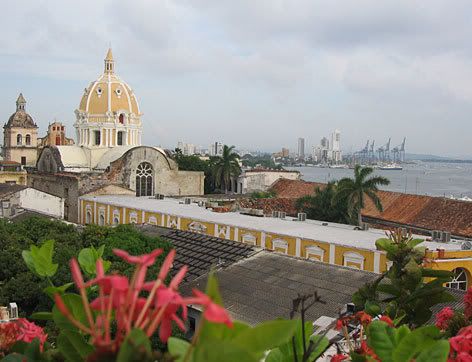
Santa Marta is the oldest city in Colombia, and it's where we'll be spending most of our time. Santa Marta was founded in 1525 by Spanish in conquistador Rodrigo de Bastidas (unfortunately, Wikipedia doesn't provide any information about the people who lived in Santa Marta before the Spanish). Santa Marta is one the most popular tourist destinations in Colombia and has great beaches (or so I'm told).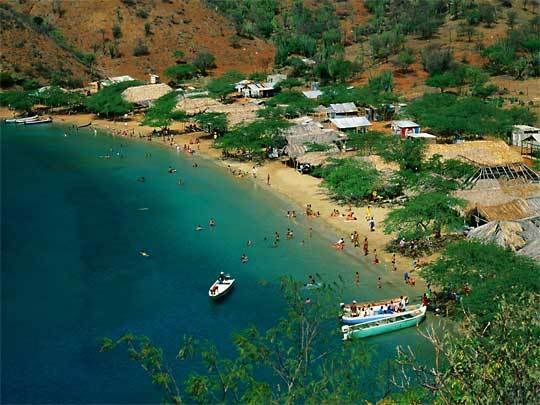
Well, I'll do my best to keep everyone up to date while I'm traveling! I'll be sure to take lots of pictures! (I'll also be doing regular posts).
Posted by
Margaret
at
5:04 AM
4
comments
![]()
![]()
Tuesday, June 10, 2008
Sanderson Fabrics
This lovely living room has been decorated using Sanderson's beautiful floral fabrics. If the designs seem familiar, it's because their patterns are copied or "adapted" by a number of other design firms. I suppose imitation is the sincerest form of flattery!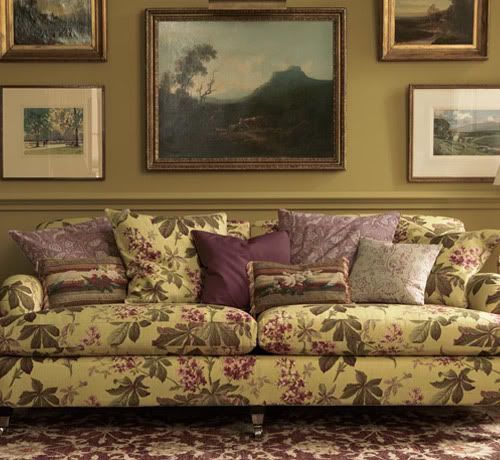
Sandersons is one of the oldest and best respected names in interior decorating. The company was established in 1860 as a firm specializing in interior design and decorating. Later, in 1923 Arthur Sanderson & Sons was awarded the Royal Warrant as Purveyors of Wallpapers to the King. In 1955 the company was again awarded the Royal Warrant to supply wallpapers, paints and fabrics to Queen Elizabeth II and the company continues to supply the Queen today.
Sanderson produces a wide variety of decorating materials, but they are best known for their floral wall papers and fabrics. Until recently, Sanderson had an exclusive copyright on William Morris' wallpaper and textile designs. In fact, Morris and Company's original designs were purchased by Sanderson some time ago and the Morris and Company website is actually a subsidiary of Sanderson's parent company, Walker Greenbank. The Morris and Company website is a great resource where you can find everything from decorating fabric to heritage paint colours. 

Today you can purchase William Morris' designs from other companies, but Sanderson's are still recognized as the best quality. Their fine fabrics are guaranteed to last for years.
images courtesy sanderson-uk.com
Posted by
Margaret
at
5:48 AM
8
comments
![]()
![]()
Labels: decorating, textiles, william morris
Monday, June 9, 2008
Society for the Protection of Ancient Buildings
The Society for the Protection of Ancient Buildings was originally founded in 1877 by William Morris and several leading members of the Pre-Raphaelite Brotherhood. Affectionately referred to by Morris and his pals as "Anti-Scrape," the society was founded with the goal of preventing England's ancient buildings from being destroyed in "restoration" projects.
The SPAB's work is guided by a number of principles, the chief of which is the maxim "repair, not restore." The Society believes that "age can confer a beauty of its own." Moreover, gentle signs of aging on a building "are qualities to care for, not blemishes to be eradicated." This philosophy has had a major influence on how many of us view historic preservation today.
The Society for the Protection of Ancient Building's emphasis on repairing--rather than restoring--buildings has gradually become the rule when it comes to architectural preservation. Most curators now adhere to the SPAB's philosophy of preserving the integrity of historical structures, but the SPAB's influence is not limited to academic circles. The society's legacy can also be seen in thee fact that many homeowners and lovers of antique objects have begun to prize preservation over restoration. Interestingly, if you're a fan of antique-appraisal shows like "Antiques Roadshow" you'll see that this approach now applies to antiques as well (furniture that displays it's original finish is always much more valuable).
Today, the SPAB has over 7,500 members and is active in educating homeowners about how to go about repairing their homes. They also provide advice on how to repair churches and other historical landmarks. Be sure to take a look at their website to find out more!
Posted by
Margaret
at
5:32 AM
3
comments
![]()
![]()
Labels: architecture, william morris
Friday, June 6, 2008
Preparing for Thesis Defense, Baby and Travel

It's amazing how everything happens at once! The past few days have gone by in such a whirl and I'm sure this weekend will as well. Right now I'm putting the finishing touches on my thesis and preparing for my defense, which will be Monday afternoon at 2pm. I can hardly believe I'm almost done!
It's been such an interesting process writing and researching my thesis. I never would have thought a couple of years ago that I would be doing my MA on the role of drugs in Colombia's economy! I was originally planning to do research on either William Morris or the history of British labour legislation--which had been my focus during my honours degree.
In addition to my thesis, I'm also expecting the arrival of my sister's first baby as well (probably by midnight tonight). She's been in the hospital since midnight last night. Everything is going well, but it's amazing how long these things take!
Finally, my husband and I are preparing for our trip to Colombia on the 12th I'm so excited to finally get a chance to visit the country I've written so much about! I'm also frankly looking forward to (hopefully) seeing Colombia from a different perspective, since I've sadly learned more about the drug industry and political corruption in the country than I have about the many lovely people that live there.
So, I've had all my vaccinations and I'm ready to go! Hopefully I'll have some time to cram some last minute spanish in before I get there. I've been working on reading spanish sources for my thesis for the past few months, but it's so different to read a language than to actually speak it. We'll see how I do.
I will be doing my best to post over the next few days, but I might be a little less punctual than usual. I just wanted everyone to know that I have a good excuse!
Have a great weekend everyone, and wish me luck on my defense Monday!
Posted by
Margaret
at
11:38 AM
9
comments
![]()
![]()
Wednesday, June 4, 2008
Limoges Porcelain Painting
On our last morning in Rennes, Monique took my mom and I to see an exhibit of the traditional art of porcelain painting that featured works done by her and her friends. They call themselves "Les Atelliers du Chardon." From what I could tell, painting china is quite popular in France and there are a lot of places that sell plain Limoges china that you can take home and paint (sort of like the ceramic painting places we have in North America, except the work these people produce is much, much finer).
The artwork was extremely high quality. I was particularly impressed by the fine detailing that the artists had used on the porcelain. I didn't get to see their brushes, but they must have been incredibly tiny!
This is Anne Pichon, who organized the exhibit, with one of her pieces. The detail on the ducks is just amazing! It would make a great lamp for someone's study. It's a little masculine for my taste, but the artwork was just lovely. It reminded me of 19th century nature drawings. Anne took her inspiration from the ducks in her garden pond.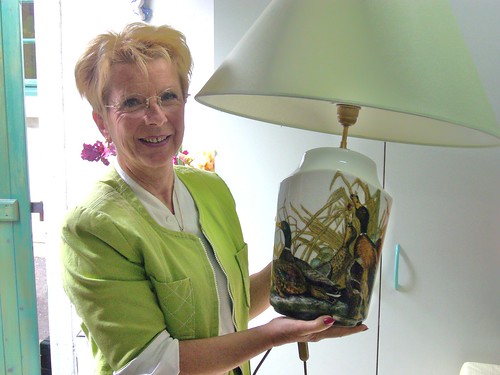
This gardenia blossom platter was one of my favourite pieces. The design was so modern and elegant. 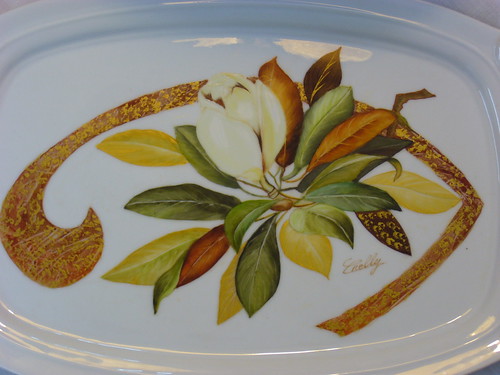
Here's a set of hand painted kitchen tiles, also painted by Anne. 
Here we are, discussing the importance of handcrafts in Anne's garden!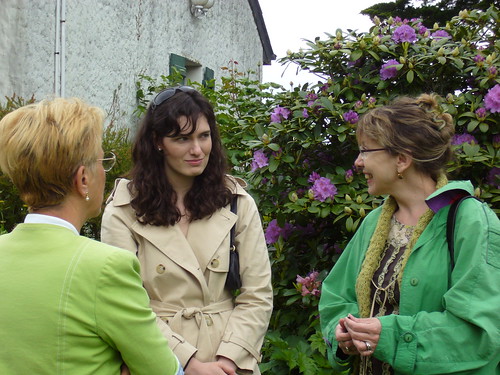
I was so impressed with the work that these ladies were doing. They are so passionate about art and about taking part in the creation of art objects for their own homes. None of the pieces of art in the exhibit were for sale, although Anne does do commissions. The ladies really just enjoyed designing beautiful one of a kind china for their own homes, which I thought was really neat.
I actually bought a number of unpainted pieces of Limoges porcelain while I was in Rennes (it's actually very inexpensive if you buy the china straight from the factories). It's so beautiful that it doesn't really need to be painted, but now I want to learn!
Posted by
Margaret
at
5:59 AM
4
comments
![]()
![]()
Tuesday, June 3, 2008
Visit to Fougères Castle
On our first day in Rennes, Monique and Pierre drove us to a lovely Medieval village of Fougères. Fougères is located near the coast in the northwest corner of France. The village is most famous for the 11th century castle that dominates the landscape.
During the medieval period, Fougères was an important commercial centre that was known for the quality of its shoe making and weaving. In the 19th century, Victor Hugo traveled to the city to find inspiration for his novels. 
This picture, taken from the interior of the castle, shows some of the details of the chateau. I was quite surprised by the size of the stones that were used to construct the castle. Most of the other castles I've seen contain are constructed out of much pieces of stone. Our friend Pierre believed that the people who originally constructed the castle used the local stones to construct the castle because there weren't any rock quarries near by, but I haven't found any research done on this. If any one knows, please share!
Oh, and I also loved all the wildflowers growing in the crooks and crannies of the castle walls!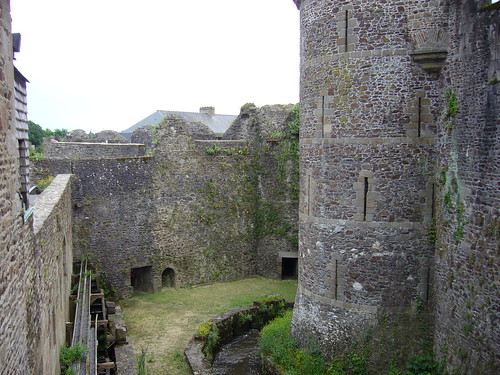
One of the most charming things about Fougères is that the oldest part of the town has been restored to its Medieval splendor. Many of the buildings now house touristy businesses like traditional creperies, where you sit on the patio and enjoy some cider while taking in a view of the castle!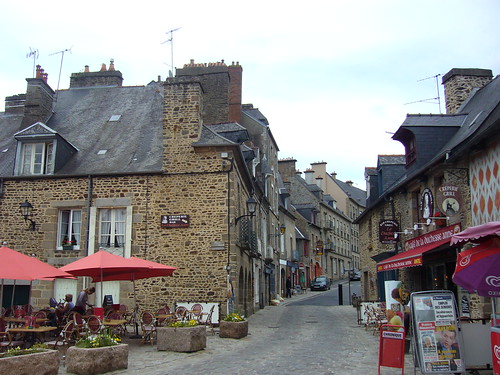
Posted by
Margaret
at
5:02 AM
4
comments
![]()
![]()
Monday, June 2, 2008
Our Wonderful Host Family in Rennes
Mom with Monique and Pierre
The highlight of my trip to France was definitely the days we spent in Rennes with my mom's friends Monique and Pierre. They were spectacular hosts (Monique is the most amazing cook! I've been more inspired in the kitchen since visiting her!).
In addition to hosting students and friends from around the world in her lovely home, Monique is an artist, writer, and president of a foundation called l'Association des Enfants du Niger, which raises funds to help orphans in Niger. Her partner, Pierre, is a writer and professor of French Literature who has spent the last 30 years traveling to Nigeria each year to teach orphans. They were some of the most incredible people I've ever met, and staying with them really reminded me that people are always the best part of traveling to new places.
Me and Monique 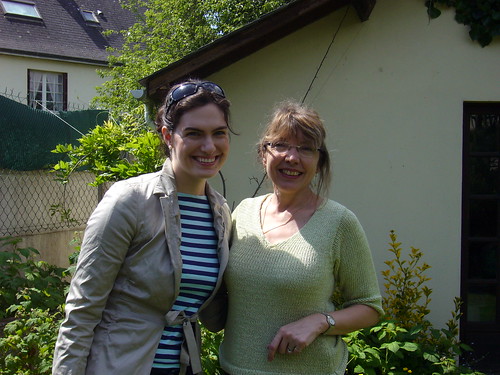
Staying with Monique and Pierre was also a great opportunity to practice my french! I have never spoken so much [bad] french in my life before! It was a great opportunity though.
When we left, Monique presented me with a copy of her charming children's book, Pépère au Niger, which she wrote about her cat Pepper's first visit to Niger!
Finally, here's a picture of me getting to know Caroline, Monique's pet garden turtle (she had half a dozen pet turtles in the garden). I loved the turtles, especially Caroline. Who would have ever thought that a tortoise would have such a great personality! I think they are the perfect pets--they just eat things in the garden--you don't even have to feed them. Plus, according to Monique they stay in the yard. The only problem is that I think they'd probably freeze to death in Edmonton.
Posted by
Margaret
at
5:26 AM
5
comments
![]()
![]()
Labels: travel
Sunday, June 1, 2008
We've moved, please update your links
Thank you for your patience, everyone! The transition to the new domain went pretty smoothly. The site was only down for a couple of hours, which is pretty good!
Since this blog has moved, please update your links/bookmarks to point to the new address. A special note to subscribers: if anyone has any problems with the site's feed, please let me know by emailing me or by commenting on this post.
Thank you again!
Margaret
Posted by
Margaret
at
2:09 PM
2
comments
![]()
![]()
Labels: blogging

